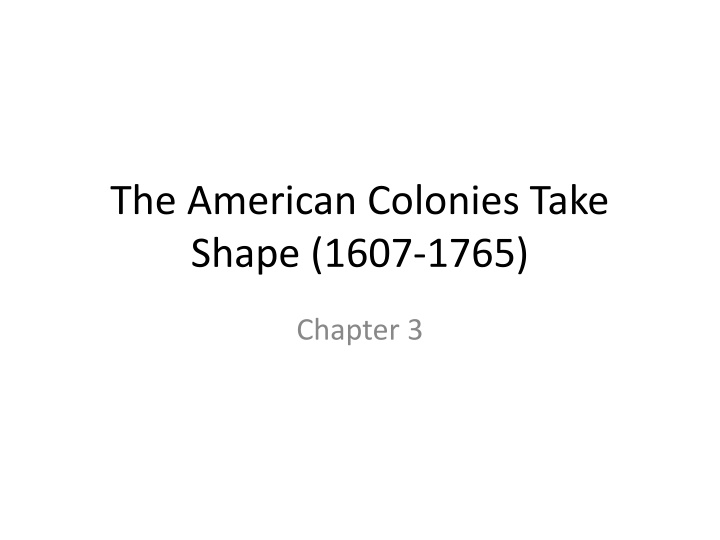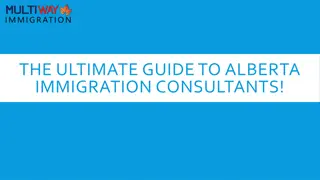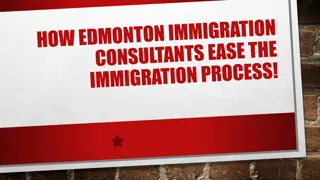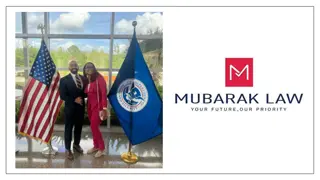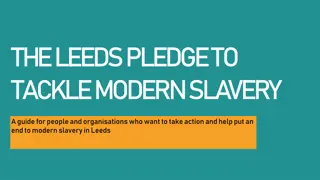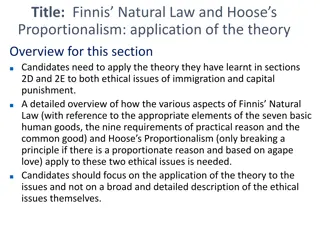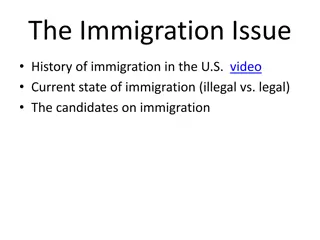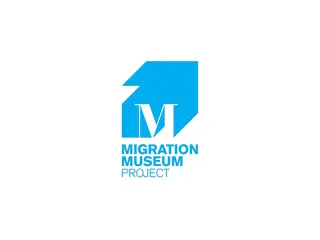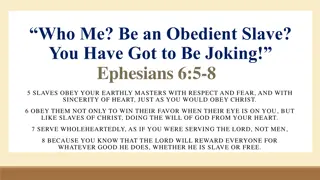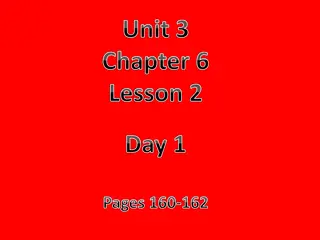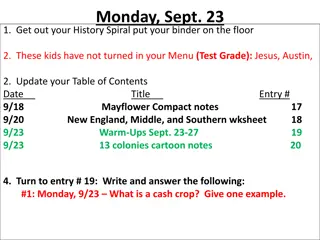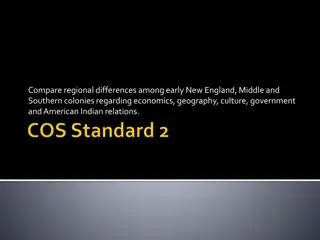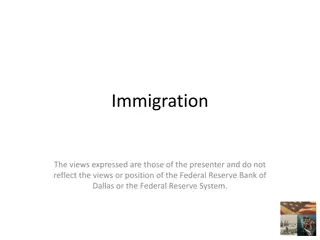Immigration and Slavery in the American Colonies (1607-1765)
The American colonies experienced significant immigration, with English, Irish, and German settlers seeking a new beginning. Many English immigrants were indentured servants, while Irish and German immigrants faced push factors like war and religious persecution. Additionally, the slave trade played a major role in the colonies, with African slaves enduring the harrowing Middle Passage to America. Slavery was particularly prevalent in the Southern colonies, where conditions were harsh. Overall, immigration and slavery shaped the demographic landscape of the American colonies during this period.
Uploaded on Oct 06, 2024 | 1 Views
Download Presentation

Please find below an Image/Link to download the presentation.
The content on the website is provided AS IS for your information and personal use only. It may not be sold, licensed, or shared on other websites without obtaining consent from the author.If you encounter any issues during the download, it is possible that the publisher has removed the file from their server.
You are allowed to download the files provided on this website for personal or commercial use, subject to the condition that they are used lawfully. All files are the property of their respective owners.
The content on the website is provided AS IS for your information and personal use only. It may not be sold, licensed, or shared on other websites without obtaining consent from the author.
E N D
Presentation Transcript
The American Colonies Take Shape (1607-1765) Chapter 3
Immigration and Slavery Section 1
Migration 80 - 90% of England s colonies were filled with English immigrants Most were indentured servants Worked 4-7 years in exchange for passage to the New World
Immigration Many Irish from IRELAND immigrate Over 250k Irish move to America Came to look for a new beginning Move westward to PA in order to farm
Germans 100k: Most were Protestant War, taxes and religion forced many to come here (Push factors) William Penn recruited many Germans to his territory
Slave Trade 1 in 5 colonists (20%) are African slaves Triangular trade is 3 way trade b/w Africa, America and Europe 37% taken to Brazil / 41% Non-Spanish Caribbean 15% taken to Spanish America 4.5% taken to American Colonies
Middle Passage (Africa New World) 6 8 week journey from Africa to New World Slaves were shackled and packed into ships lowest levels Each floor was 3ft 3in high Between 10 and 40% of slaves would die on the way due to: lack of sanitation, air, and SUICIDE
http://upload.wikimedia.org/wikipedia/commons/thumb/a/ac/Triangular_trade.png/250px-Triangular_trade.pnghttp://upload.wikimedia.org/wikipedia/commons/thumb/a/ac/Triangular_trade.png/250px-Triangular_trade.png
Slavery in Southern Colonies South Carolina Over 50% of population Georgia Over 33% of population Excelled in growing rice b/c they did that in their homeland Separated from their families so other slaves would step into family roles Experienced WORSE physical conditions of all slaves
New England / Middle Colonies Only about 5k total : 1/8 of what was in the Southern colonies More freedom to choose what to do / families kept together Worked as skilled laborers: Lumberjacks, artisans, shipbuilding, fishermen, whalers, and cooks
Free Africans Not FREE until after the American Revolution (only in the North) Usually did the same job as slaves but lived in worse economic conditions (less food / worse shelter ) bc they had to buy their own now Could not vote or marry white Americans
Laws / Revolts Changed from colony to colony Slaves generally could not leave town without a pass Also needed a pass to board any ship Stono Rebellion
Section 1 Review: 1. Why did most German immigrants come to America? 2. Where did the MOST of the African Slaves get taken to? 3. Describe the MIDDLE PASSAGE. 4. What were 3 of the jobs a slave could do in NEW ENGLAND?
The American Colonies and England Section 2
King Pounding Fist Animated Clipart Magna Carta (1215) Limited power of the King Set limitations on TAXES the King could set / must ask nobles Gave right to trial (not always fair) Quick or speedy justice
Bill of Rights (1689) Habeas Corpus: Can t be held (in jail) w/o being charged w/ a crime No army in times of peace (lowered taxes) King could not limit free speech Right to bear arms / no cruel or unusual punishment
Consumer Revolution Colonists were SELF SUFFICIENT (survived w/o others help) With the new TRANSATLANCTIC trade they could buy goods from Europe Survival was now possible from outside sources
Navigation Acts Laws set to make England wealthy 1. Colonies must ship TOBACCO and SUGAR to ENGLAND only 2. Any goods arriving in colonies must be brought through an ENGLISH port for TAXATION This ensured taxes were paid on all goods brought to the colonies
Triangular Trade Raw materials (timber, tobacco) to from America to Europe Manufactured goods (guns, chairs) from Europe to Africa Enslaved Africans from Africa to America (Middle Passage)
http://upload.wikimedia.org/wikipedia/commons/thumb/a/ac/Triangular_trade.png/250px-Triangular_trade.pnghttp://upload.wikimedia.org/wikipedia/commons/thumb/a/ac/Triangular_trade.png/250px-Triangular_trade.png
New Ideas: Enlightenment Scientific Revolution Used Physics and Math to explain the world (scientific method) People like Isaac Newton and Ben Franklin Leads to inventions: Lightning rod, bifocal glasses
Great Awakening Religious movement in the 13 American Colonies Opposite of Enlightenment Claimed God was responsible for everything and the Earth s creation Many African slaves find it appealing and convert to Christianity for the 1sttime
Section 2 Review: 1. List 2 parts of the MAGNA CARTA. 2. What does Habeas Corpus mean? 3. Through the NAVIGATION ACTS what 2 crops must be traded to England only? 4. Compare the ENGLIGHTENMENT to the GREAT AWAKENING.
Comparing Regional Cultures Section 3
Polar Bear Ice Fishing Animated Clipart New England Cold climate = Little farming Fish / timber were major EXPORTS Boston was biggest trading port Generally wealthier people came here
Middle Colonies Temperate climate / some farming WHEAT was major export Philly and NY were biggest cities (25k) Mostly English immigrants
Sunshine Icon Animated Clipart The South Warmest climate = Mostly farming Produced most valuable crops; rice, indigo, TOBACCO Most profitable area to live / did NOT pay workers Used slaves to cultivate (grow) crops
Women Women were PROPTERY of men Jobs included: Cook / clean Could not : Vote Sew / laundry Own land Garden Hold office Child care
Education New Englanders learned to read by reading the BIBLE daily Usually children were home schooled Wealthy could hire a tutor Harvard 1stColonial University (150 students)
Public School 1 Room school house; walked from miles around All grades in same room Subjects were: Reading, writing and arithmetic Teachers were mostly female Rules were VERY STRICT
Punishment Fine and EXPULSION for the following offenses: Fighting Bad language Lying Challenging authority
Section 3 Review: 1. What was the major export of New England? Why? 2. What was the climate of the Middle Colonies? 3. Which area produced the most VALUABLE crops? 4. Describe the role of women, in the past.
The French and Indian War Section 4
French / Indian War 1754 1763 Known as the 7 years war in Europe Fought between France (and Indians) versus England and their territories in America Soldier with gun advancing cautiously Animated Clipart
Causes of War Rivalry (competition) between Britain and France French settlements were inland (Mid West), built FORTS English settlements were along the coast and they cleared land for agriculture and built TOWNS
Benjamin Franklin Pennsylvania; Creates ALBANY PLAN of UNION Its purpose was for a unified (ALL COLONIES) war effort against the French All Colonies to essentially fight together 1stPostmaster of PA
George Washington From Virginia Colony English Colonial commander Shot 4x but survives Loses 1stbattle
Fort Necessity 900 French vs. almost 2,000 British 3 hour battle, 1/3 of British troops killed British fought in straight lines French used mobile warfare
England Wins! British Prime Minister borrows huge sums of money to fight the war British troops better prepared and defeat the French in Western PA British would take Fort Duquesne and Fort Niagara
Treaty of Paris 1763 Officially ends the French Indian War in America Canada and all lands east of the Mississippi river except New Orleans annexed (taken) by England Flag with Peace Sign Waving Animated Clipart England trades Cuba for Florida
Section 4 Review: 1. Who fought in the French Indian War? Who won? 2. What did BEN FRANKLIN create? 3. Which commander was shot 4x? 4. Describe the battle at Fort Necessity.
